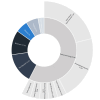AI-Based Noninvasive Blood Glucose Monitoring: Scoping Review
- PMID: 39561353
- PMCID: PMC11615544
- DOI: 10.2196/58892
AI-Based Noninvasive Blood Glucose Monitoring: Scoping Review
Abstract
Background: Current blood glucose monitoring (BGM) methods are often invasive and require repetitive pricking of a finger to obtain blood samples, predisposing individuals to pain, discomfort, and infection. Noninvasive blood glucose monitoring (NIBGM) is ideal for minimizing discomfort, reducing the risk of infection, and increasing convenience.
Objective: This review aimed to map the use cases of artificial intelligence (AI) in NIBGM.
Methods: A systematic scoping review was conducted according to the Arksey O'Malley five-step framework. Eight electronic databases (CINAHL, Embase, PubMed, Web of Science, Scopus, The Cochrane-Central Library, ACM Digital Library, and IEEE Xplore) were searched from inception until February 8, 2023. Study selection was conducted by 2 independent reviewers, descriptive analysis was conducted, and findings were presented narratively. Study characteristics (author, country, type of publication, study design, population characteristics, mean age, types of noninvasive techniques used, and application, as well as characteristics of the BGM systems) were extracted independently and cross-checked by 2 investigators. Methodological quality appraisal was conducted using the Checklist for assessment of medical AI.
Results: A total of 33 papers were included, representing studies from Asia, the United States, Europe, the Middle East, and Africa published between 2005 and 2023. Most studies used optical techniques (n=19, 58%) to estimate blood glucose levels (n=27, 82%). Others used electrochemical sensors (n=4), imaging (n=2), mixed techniques (n=2), and tissue impedance (n=1). Accuracy ranged from 35.56% to 94.23% and Clarke error grid (A+B) ranged from 86.91% to 100%. The most popular machine learning algorithm used was random forest (n=10) and the most popular deep learning model was the artificial neural network (n=6). The mean overall checklist for assessment of medical AI score on the included papers was 33.5 (SD 3.09), suggesting an average of medium quality. The studies reviewed demonstrate that some AI techniques can accurately predict glucose levels from noninvasive sources while enhancing comfort and ease of use for patients. However, the overall range of accuracy was wide due to the heterogeneity of models and input data.
Conclusions: Efforts are needed to standardize and regulate the use of AI technologies in BGM, as well as develop consensus guidelines and protocols to ensure the quality and safety of AI-assisted monitoring systems. The use of AI for NIBGM is a promising area of research that has the potential to revolutionize diabetes management.
Keywords: accuracy; artificial intelligence; blood glucose; deep learning; diabetes; health informatics; heterogeneity; machine learning; management; mobile phone; monitoring; noninvasive; scoping review; self-monitoring.
©Pin Zhong Chan, Eric Jin, Miia Jansson, Han Shi Jocelyn Chew. Originally published in the Journal of Medical Internet Research (https://www.jmir.org), 19.11.2024.
Conflict of interest statement
Conflicts of Interest: None declared.
Figures




References
-
- IDF Diabetes Atlas 2021. Belgium: International Diabetes Federation; 2021. - PubMed
-
- Duckworth W, Abraira C, Moritz T. Glucose control and vascular complications in veterans with type 2 diabetes. J Vasc Surg. 2009 Apr;49(4):1084. doi: 10.1016/j.jvs.2009.02.026. - DOI
-
- Lee A, Juraschek SP, Windham BG, Lee CJ, Sharrett AR, Coresh J, Selvin E. Severe hypoglycemia and risk of falls in type 2 diabetes: the atherosclerosis risk in communities (ARIC) study. Diabetes Care. 2020 Sep;43(9):2060–2065. doi: 10.2337/dc20-0316. https://europepmc.org/abstract/MED/32611607 dc20-0316 - DOI - PMC - PubMed
-
- Nakhleh A, Shehadeh N. Hypoglycemia in diabetes: an update on pathophysiology, treatment, and prevention. World J Diabetes. 2021 Dec 15;12(12):2036–2049. doi: 10.4239/wjd.v12.i12.2036. https://www.wjgnet.com/1948-9358/full/v12/i12/2036.htm - DOI - PMC - PubMed
-
- Rodbard D. Continuous glucose monitoring: a review of recent studies demonstrating improved glycemic outcomes. Diabetes Technol Ther. 2017 Jun;19(S3):S25–S37. doi: 10.1089/dia.2017.0035. https://europepmc.org/abstract/MED/28585879 - DOI - PMC - PubMed
Publication types
MeSH terms
Substances
LinkOut - more resources
Full Text Sources

